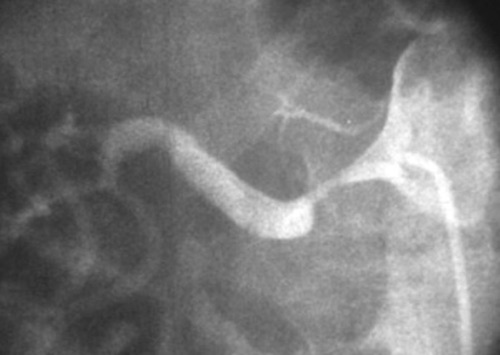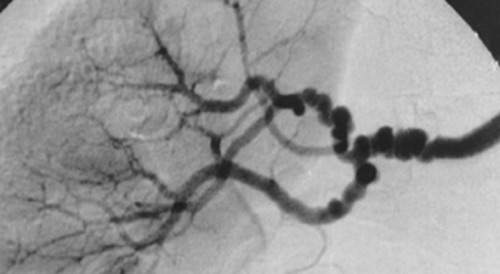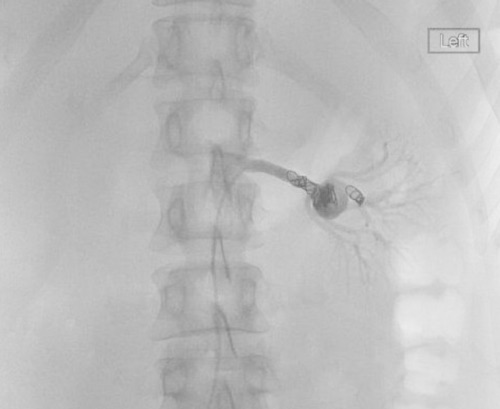Vascular: Renovascular Disease
Renovascular Disease
Presentation
- Renovascular Hypertension
- Hypoperfusion of Juxtaglomerular Complex Causes Increased Renin & RAAS Activation
- Often More Severe & Resistant to Antihypertensive Medications Than Essential Hypertension
- May See More Severe Diastolic Elevations
- RAAS Effects:
- Unilateral Disease: Unaffected Kidney Causes Compensatory RAAS Activation
- Renin-Dependent, Euvolemic Hypertension – Renin Produced by Affected Kidney
- Bilateral Disease: No Compensatory Response
- Volume-Dependent, Hypervolemic Hypertension – By Negative Feedback Has Normal/Low Renin
- Unilateral Disease: Unaffected Kidney Causes Compensatory RAAS Activation
- Ischemic Nephropathy
- Contralateral Kidney Can Be Injured from Compensatory Systemic Hypertension by RAAS Activation
- Generally Only from Severe Disease
- Renal Insufficiency With Only Mild-Moderate Hypertension is Unlikely to Improve with Revascularization
Causes
- Atherosclerosis
- Most Common Cause (80-90%)
- Typically Most Severe at the Ostia
- Most Common Side: Left
- Most Common in Men
- Fibromuscular Dysplasia
- Nonatheromatous Noninflammatory Proliferative Process
- Most Common in Women Age 20-60
- Seen Predominantly in the Middle Segment of the Renal Artery
- Typically Affects the Main Artery & Distal Branches
- Most Common Site: Right
- “String of Beads” Appearance from Alternating Stenosis & Dilation
- Other Sites:
- *See Vascular: Arteriopathies
- Dissection
- Aneurysms
- Trauma
Diagnosis
- Screen: Duplex US
- Renal Artery Systolic Velocity > 180 cm/s
- Renal Artery-to-Aorta Velocity Ratio > 3.5
- CTA or MRA are Excellent Tests but May Risk Nephrotoxicity
- Gold Standard: Digital Subtraction Angiography (DSA)
- More Difficult & Invasive – Typically Only Used if Planning Reconstruction

Renal Artery Stenosis 1

FMD of Renal Artery, “String of Pearls” Appearance 2
Treatment
- Mild-Moderate Disease: Medical Management
- Antihypertensives
- First-Line: ACE-I & ARB
- Often Requires Multiple Medications with Different Classes
- In Atherosclerosis Include: Statins & Antiplatelets
- Antihypertensives
- Severe Refractory Disease that Fail Medical Management:
- Atherosclerosis: Angioplasty with Stent
- Fibromuscular Dysplasia: Angioplasty without Stent
- If Kidney Atrophic < 6 cm: Consider Nephrectomy
Predictors of Hypertension Improvement After Renal Revascularization
- Short Duration of Hypertension Prior to Diagnosis – Strongest Clinical Predictor
- Failure of Medical Therapy
- Intolerance of Medical Therapy
- Recurrent Flash Pulmonary Edema
- Refractory Heart Failure
Renal Artery Aneurysm
Basics
- Most Common Cause: Atherosclerosis & Congenital Defects
- Typically Involves Branch Arteries
- Rarely Limited to the Main Artery
Treatment Indications
- Rupture
- Symptomatic
- > 2-3 cm
- Pregnancy (High Risk of Rupture/Mortality)
- Severe Refractory Hypertension that Fails Medical Management
Treatment
- Rupture: Resection & Nephrectomy
- May Consider Reconstruction if Stable with Bleeding Quickly Controlled & Straight-Forward Repair
- Elective Repair:
- Endovascular Stent
- Preferred if Limited to the Main Artery
- Avoid if Aneurysm Extends into the Branches
- Coil Embolization
- Open Aneurysmorrhaphy with Patch Angioplasty
- Endovascular Stent

Renal Artery Aneurysm 3
References
- Chain S, Luciardi H, Feldman G, Berman S, Herrera RN, Ochoa J, Muntaner J, Escudero EM, Ronderos R. Diagnostic role of new Doppler index in assessment of renal artery stenosis. Cardiovasc Ultrasound. 2006 Jan 25;4:4. (License: CC BY-2.0)
- Plouin PF, Perdu J, La Batide-Alanore A, Boutouyrie P, Gimenez-Roqueplo AP, Jeunemaitre X. Fibromuscular dysplasia. Orphanet J Rare Dis. 2007 Jun 7;2:28. (License: CC BY-2.0)
- Cooper SS, Baldwin R, Mlynarczyk C, Hellenthal NJ. Renal Ganglioneuroma Presenting as an Apparent Renal Artery Aneurysm. Urol Case Rep. 2015 Mar 14;3(3):86-8. (License: CC BY-NC-ND-4.0)